Dubrovnik |
George Bernard Shaw famously labelled it the “Pearl of the Adriatic". The late Pope John Paul II was a fan and was even made an honorary citizen. With its old town that became a UNESCO World Heritage site in 1979, it’s not hard to see why GBS wrote "those who seek paradise on Earth should see Dubrovnik".
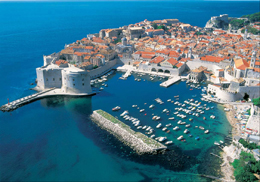
The last time I travelled to Croatia was 35 years ago when it was part of the Yugoslav Federation. Despite the brochures that I had picked up at the Arabian Travel Market tagged with the marketing line The Mediterranean as it Used to Be, I was delighted to find that apart from a few shelled buildings and walls riddled with bullet holes from the civil war of 15 years ago, the marketers had got it right. No Starbucks; no McDonalds; not even speed cameras on the roads. Just a bunch of smiling people glad to have the tourists returning back to their country and going out of their way to make them feel welcome.
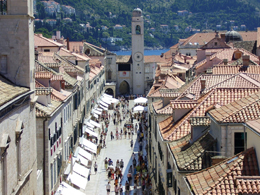
Dubrovnik is situated on the Dalmatian coast at the extreme southern end of Croatia, close to the border with Montenegro. It is one of the most prominent tourist resorts in the Mediterranean, the proudest feather in Croatia's tourist cap, a seaport which rose to prominence as an important Mediterranean sea power from the 13th century onwards. It became the only city-state in the Adriatic to rival Venice but managed to survive many centuries, with constant threats to its territory, particularly from the mighty Ottoman Empire and Venice. Supported by its wealth and skilled diplomacy, the city achieved a remarkable level of development during the 15th and 16th centuries. Although severely damaged by an earthquake in 1667, Dubrovnik managed to preserve its beautiful Gothic, Renaissance and Baroque buildings.
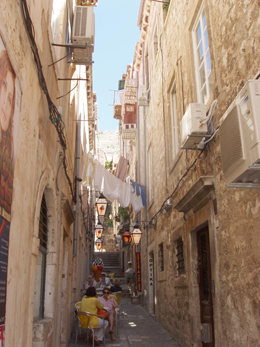
But it was damaged once again in the 1990s by armed conflict, following Croatia's declaration of independence in 1991. Serbian-Montenegrin remains of the Yugoslav People's Army attacked the city in October with a siege that lasted for seven months. Montenegro, an ally of the Serbian government led by Slobodan Milošević, declared that Dubrovnik was historically part of Montenegro. And so it was heavily bombed by the Montenegrin Navy and over 100 people were killed before the Croatian Army liberated the city and its surroundings in May 1992.
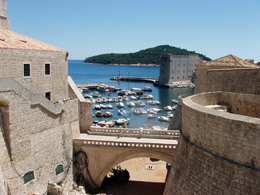
Since the end of that war, damage caused by the shelling has mostly been repaired, although there is a chart, near one of the city gates, showing all artillery hits during the siege; and if you look closely around the old town you can still see the damage from mortars in the cobblestone streets and bullet marks in the stone houses. Even now, the Croatians go out of their way to make it clear who were the goodies and who were the bad guys during the civil war. Sveti Vlaho reads a sign stuck onto the side of a mini-battleship parked on the pavement by the new harbour. The symbol and pride of resistance against Serbo-Montenegrian aggression on our town, it reads, just in case we're in any doubt.
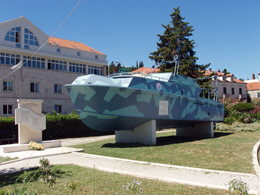
But for anyone who loves travel, Dubrovnik is steeped in stunning architecture and sculptural detail. It also boasts spectacular churches, monasteries, museums and fountains; and there are plenty of day trips to add to the overall holiday mix. The nearby towns of Kotor in Montenegro or Mostar in Bosnia-Herzegovina, for example, make for intriguing day trips.
Kotor, in fact, is the most popular of the day trips from Dubrovnik. But crossing over the border with its long queues of cars is ample illustration that though the two republics are now at peace, there is still a strong feeling of distrust between them. And despite the plethora of day trippers, Montenegrins in general refuse to accept Croatian Kuna; Euros are the order of the day – which is more of an accident than anything else. During the two years of the "new Yugoslav Republic" formed by Serbia and Montenegro it was decided that the German Mark would be the official currency; but come the demise of the Deutschmark they had no choice but to adopt the Euro, though it doesn't seem to have done them any harm!
The early autumn period in September and October is generally regarded as the best time to visit Croatia. The weather is at its most pleasant with daytime temperatures typically in the upper 20s; the sea is still quite warm, and there are also quite a lot of cultural happenings taking place.
Meanwhile, researchers at the University of Washington are working on a fascinating computing project: building 3D cities from images stored on Flickr. Known as ‘Community Photo Collections’, it has gained backing from the likes of Microsoft. The project takes large photo databases and calculates common points inside those pictures. A Dubrovnik 3D fly-by has been built, taking over 17 hours and using 58,000 pictures. This 39 second fly-by can now be seen on YouTube in HD quality, an impressive use of computational power, by any stretch of the imagination.
